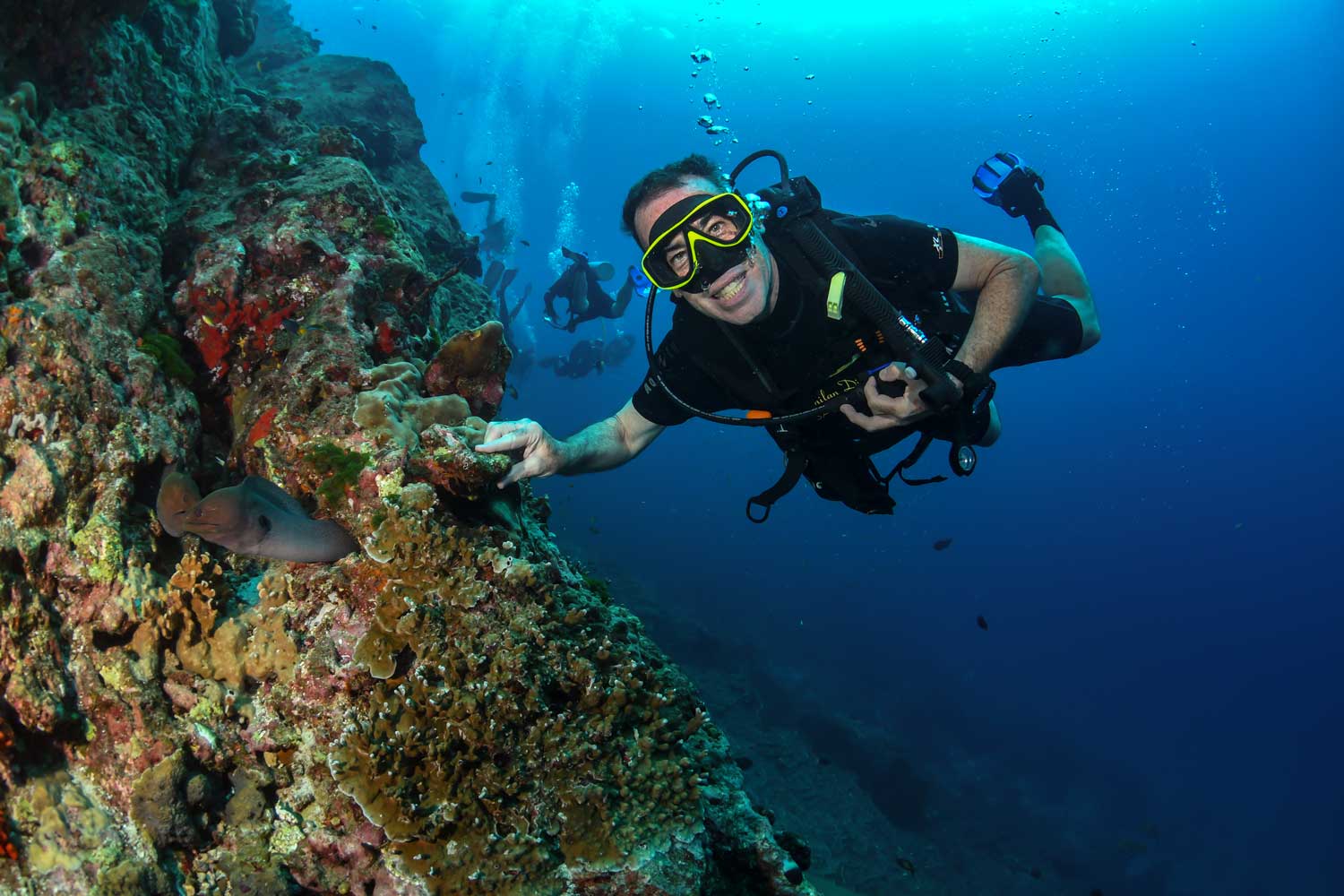
I’m posing with a pair of giant moray eels at Koh Bon.
7 December Andaman Sea
For the early morning dive we wasted no time and
made a negative descent—jumping in and going straight down—hitting 28.2 meters
as the maximum depth. Our objective was to explore the offshore pinnacle of Koh
Bon, which rises to about 20 meters and has luxuriant growths of pale yellow
soft corals and anemones that attract a lot of fish. From the pinnacle we made a
long underwater swim against the current toward Koh Bon. That seemed a waste
because I went through half a tank of air with little to see, until near the end
when we saw a young whale shark—another creature that gets us divers especially
excited!
Luca wanted to stay at Koh Bon for the late-morning dive in
hopes of seeing the whale shark again. It had moved on, but we enjoyed the dive
in the clear sparkling waters among pale yellow and purple soft corals, abundant
hard corals, and the usual profusion of fish.

I’m posing
with a pair of giant moray eels at Koh Bon.
In the afternoon we
reached Three Trees on Similan Island #9, and went down to 26 meters, where we
found mostly sand with small outcrops of corals. A layer of uninviting cold
green murky water lay in the depths. We saw both a peacock mantis shrimp in the
coral and the related spearing mantis shrimp in a hole made in the sand. A big
school of pickhandle barracuda passed by, and we saw the usual creatures such as
yellow-margin triggerfish, powder blue surgeonfish, bannerfish, angelfish,
pufferfish, and two bluespotted stingrays.
In the late afternoon we made
a shore excursion to the white sandy beach at Donald Duck Bay on Similan Island
#8. The last of the day-trippers were leaving as we arrived, so we had the place
to ourselves. Clouds made for moody skies, muting the bright colors of beach and
bay, but the air felt cool and no rain fell. We headed up the trail loop to Sail
Rock, a great granite slab atop a ridge, to enjoy views of the sea, forest, and
islands. Back in the jungle above the beach we saw several dark-hued Nicobar
pigeons (Caloenas nicobarica) hopping around; they live on islands from
the Andaman and Nicobar Islands of India east to the Malay Peninsula and on to
the Solomons and Pulau.

Our second landing party arrives at the beach.
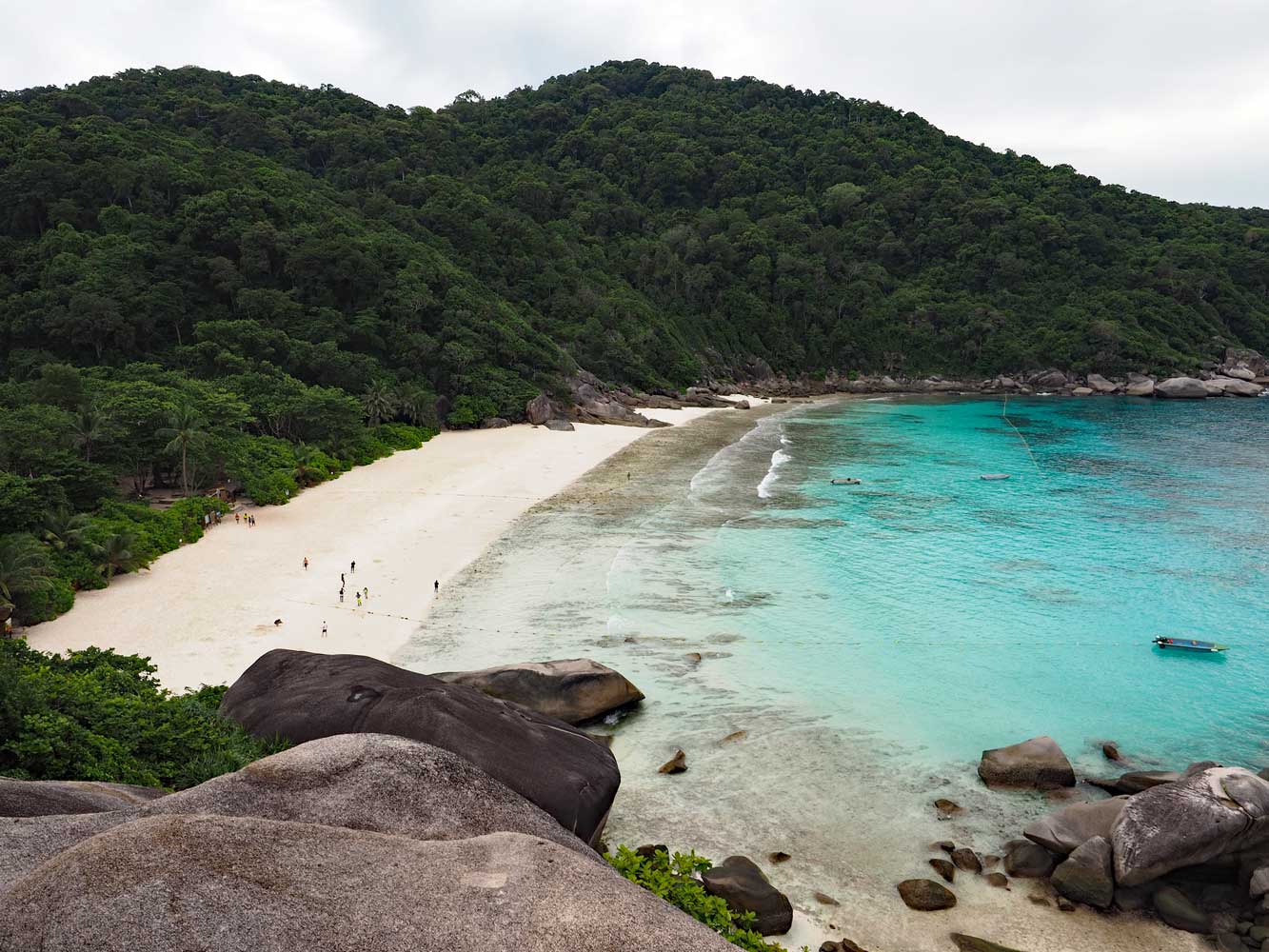
Donald Duck Bay,
named for a rock feature out of sight on the lower right.
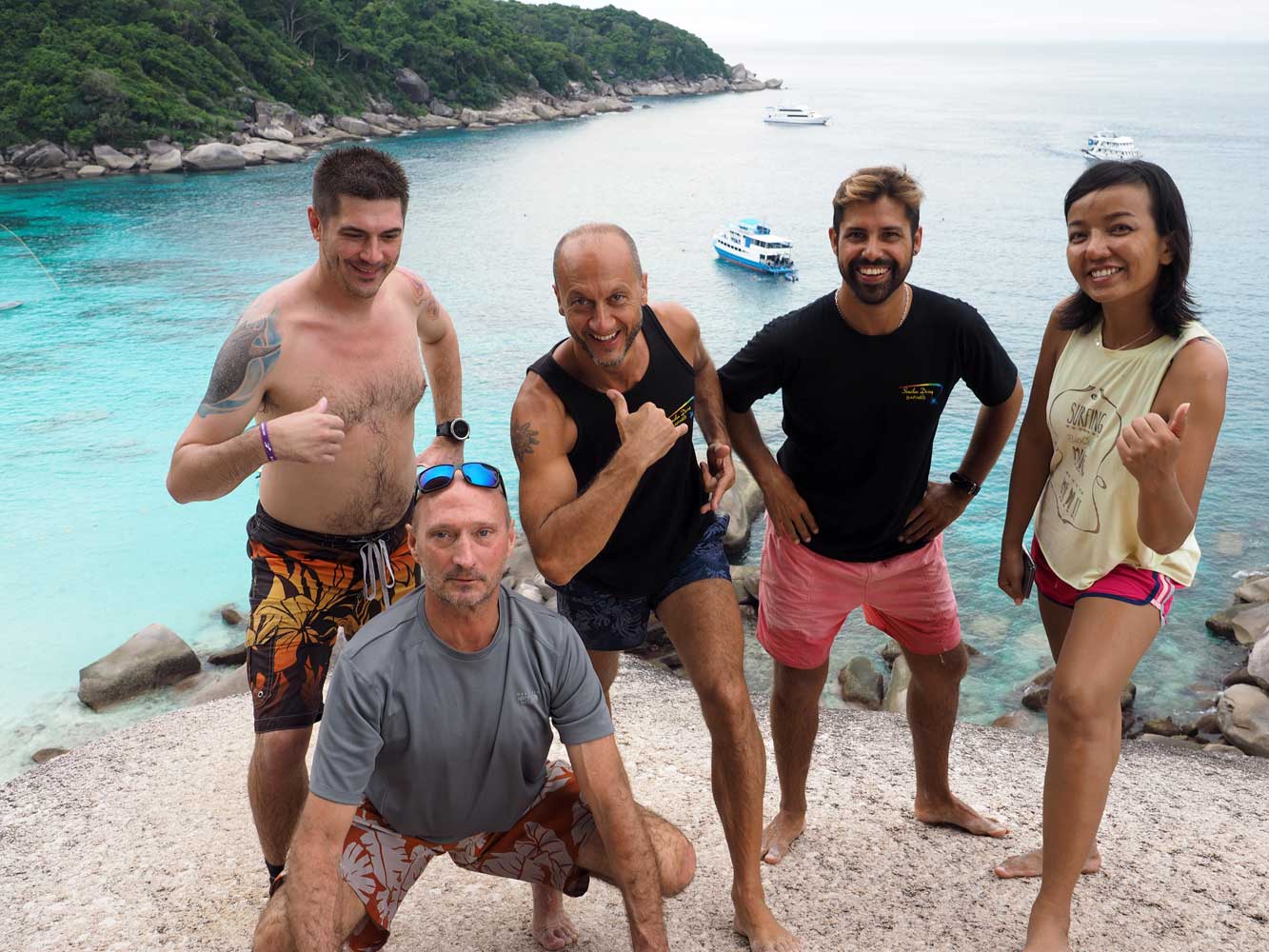
Our climbing party
celebrates arrival atop the ridge at Sail Rock.

Pablo gazes out
across Donald Duck Bay.
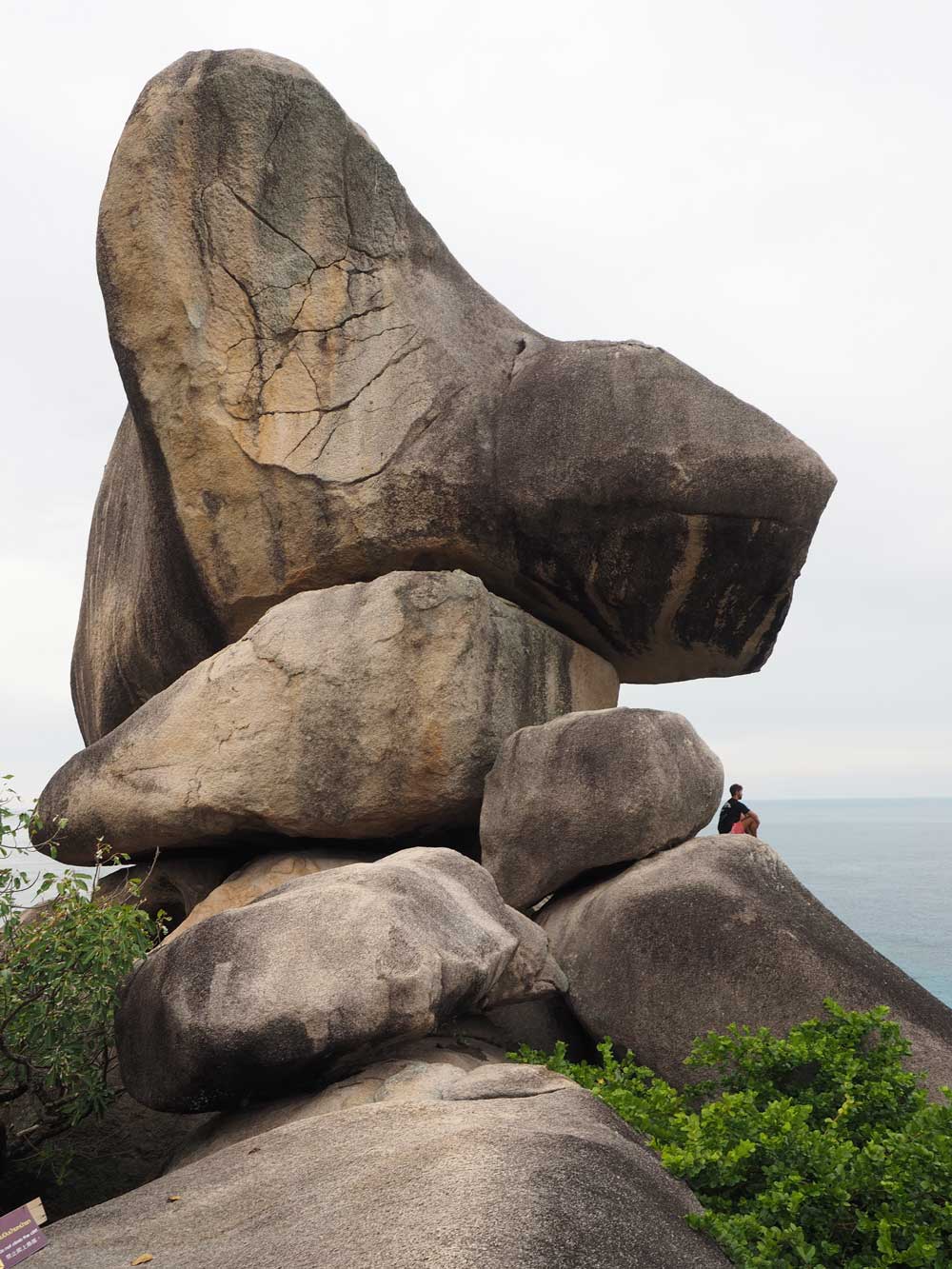
Pablo gets a few
moments of solitude beneath Sail Rock.
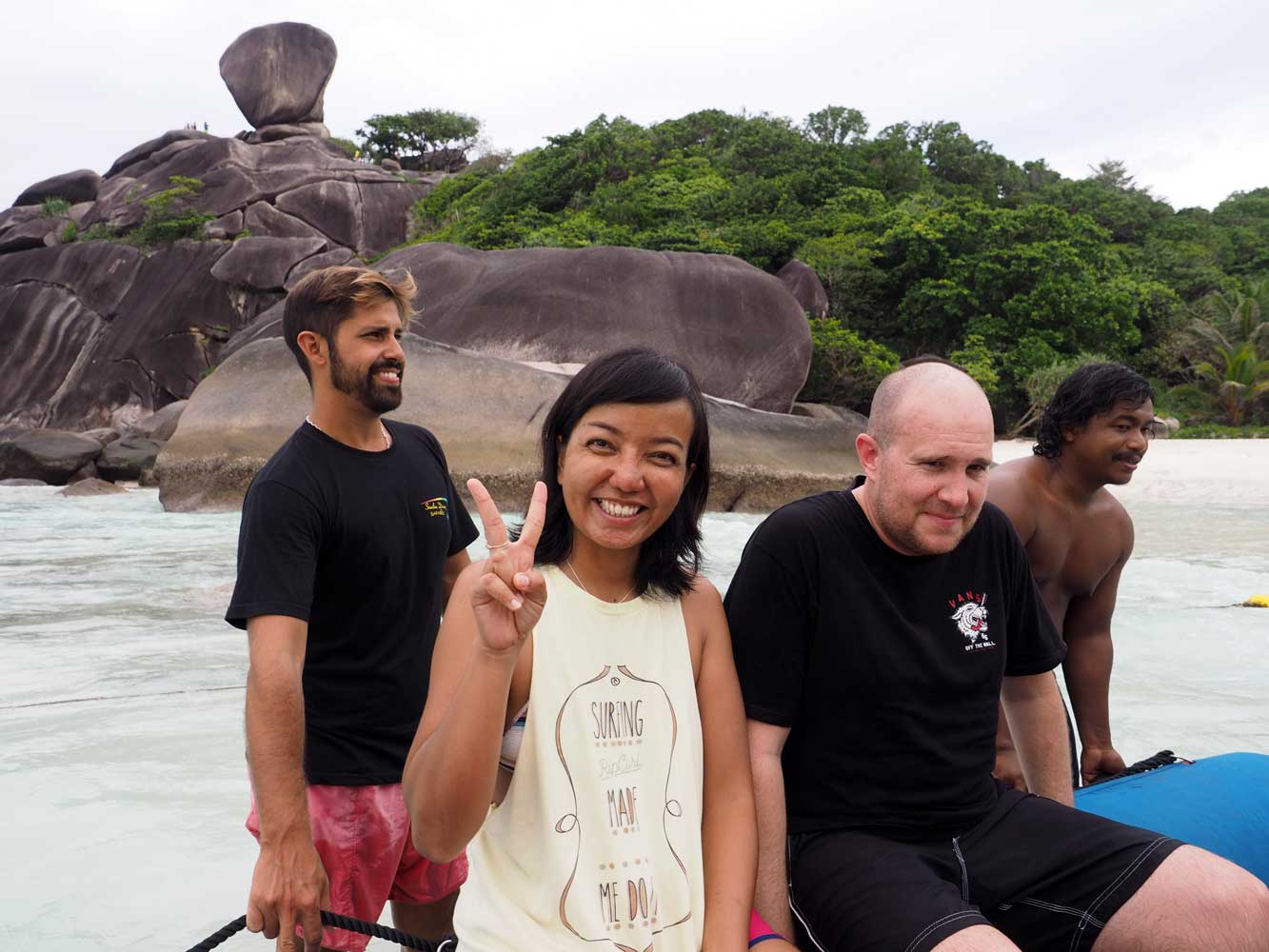
We board the dingy
for the ride back to our home. That’s Sail Rock in the background.
Our sunset dive went into the marvelous boulders, canyons, and swim-throughs at Elephant Head Rock, where we had an exciting journey through the landscape. A current and encounters with a cold thermocline added to the thrill. We saw lots of fish, of course, especially near the end of the dive, including the ‘gang’ of trevally, napoleon wrasse, and rainbow runner that like to hunt together.

Clown
triggerfish (Balistoides conspicillum) at Elephant Head Rock
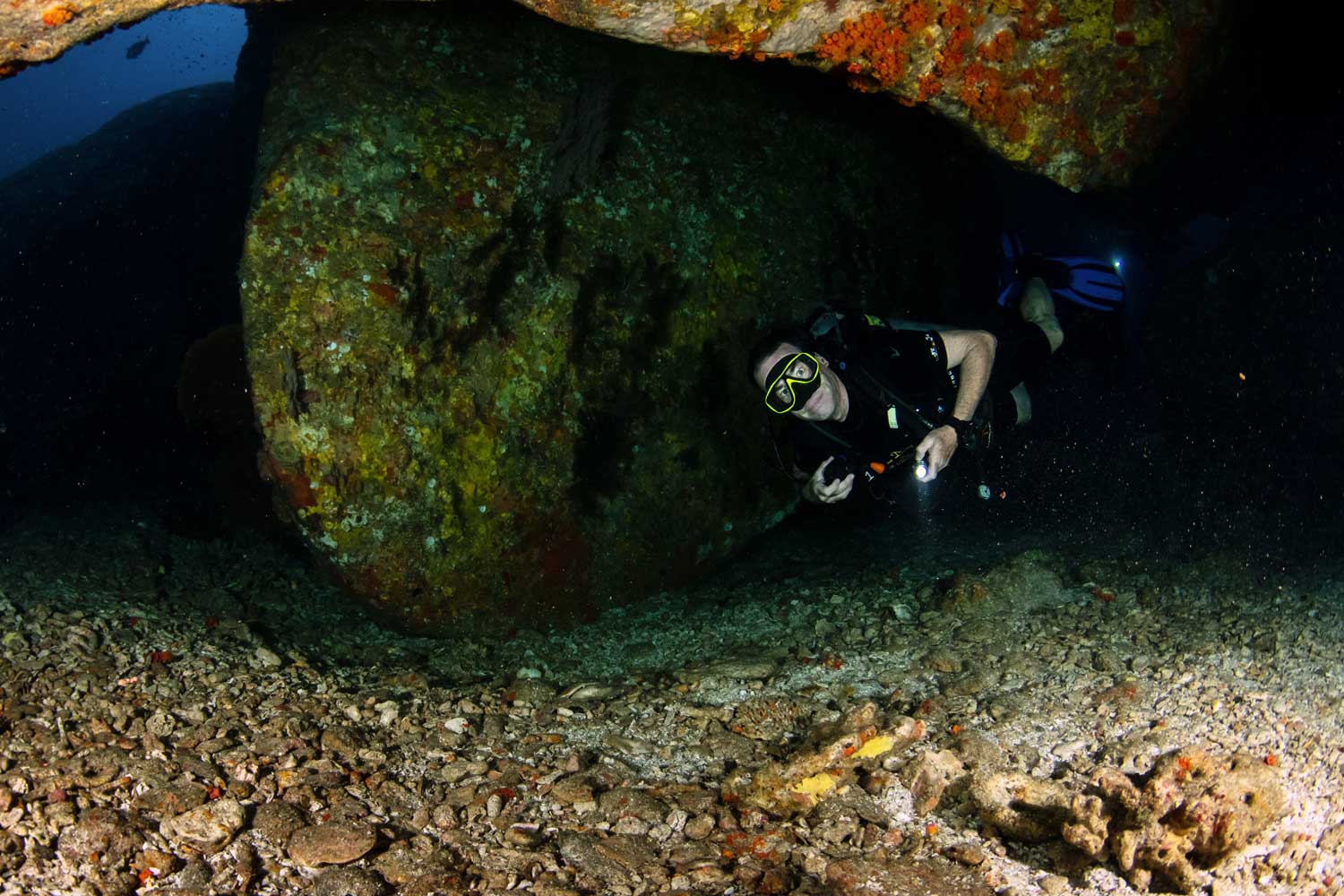
I’m coming out
of a tunnel at Elephant Head Rock.
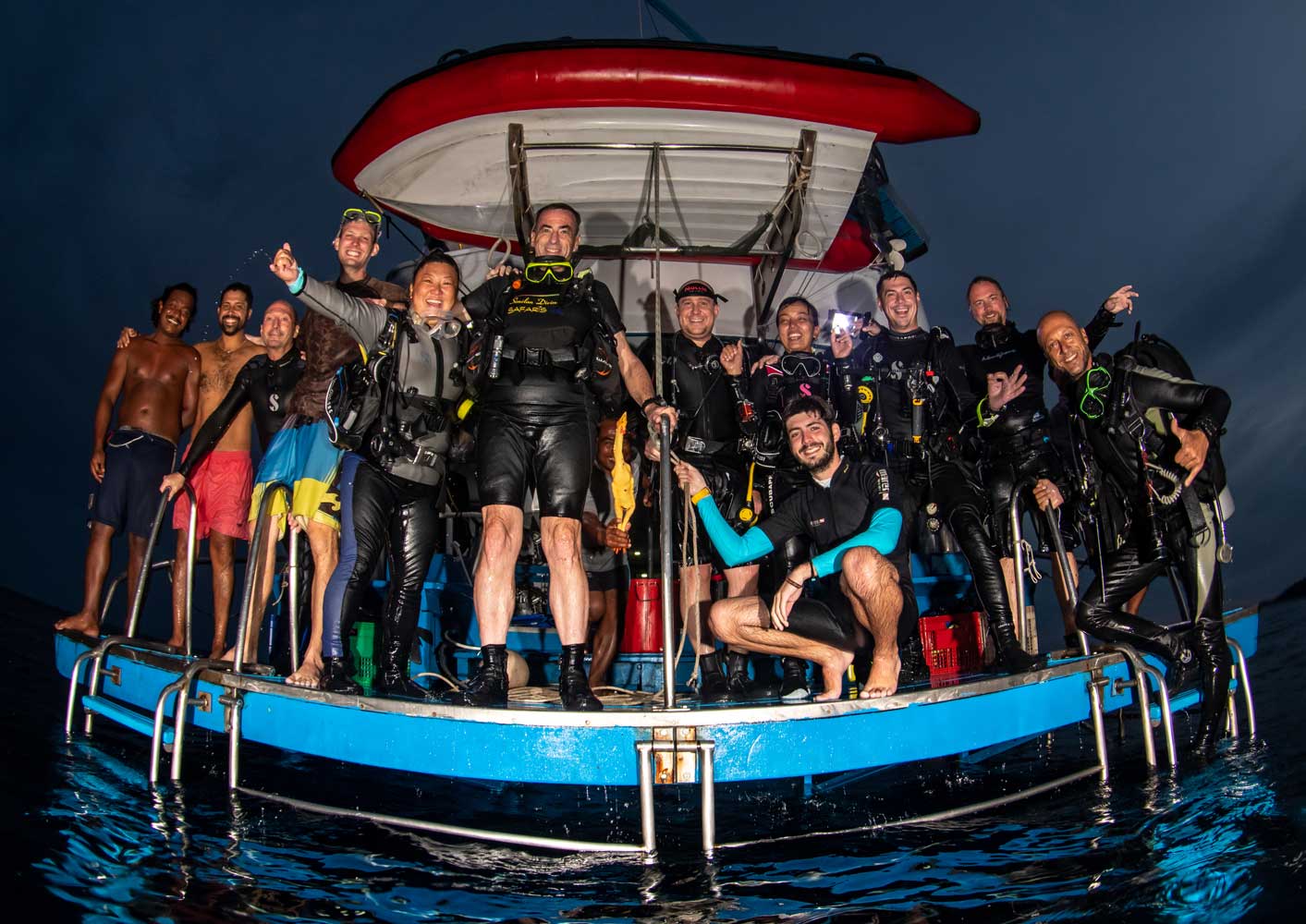
Back on the
boat after the sunset dive
8 December Phuket
Our
final two dives would be at wrecks on the way back to Tab Lamu Pier near Khao
Lak. Both wrecks provide a home and nursery for marine life in otherwise open
expanses of sand. First we explored Boonsung Wreck, a former tin mining dredge
no longer needed when tin prices had declined, so it was purposely sunk. The
2004 tsunami had broken it into several large pieces. Luca found a rare
frogfish, which looks like a little orange blob. Lots of masked porcupine fish
hung out in the shadows of the wreck. We also saw many lionfish, scorpionfish,
snappers, and nudibranches.

Frogfishes
are small, short, and stocky, and sometimes covered in spinules and other
appendages
to aid in camouflage, which gives protection from predators and
enables them to lure prey.
Many species can change color; some are covered
with other organisms such as algae or hydrozoa.
In keeping with this
camouflage, frogfishes typically move slowly, lying in wait for prey, and then
striking
extremely rapidly, in as little as 6 milliseconds (Wikipedia) It
takes a sharp eye to find one of these!
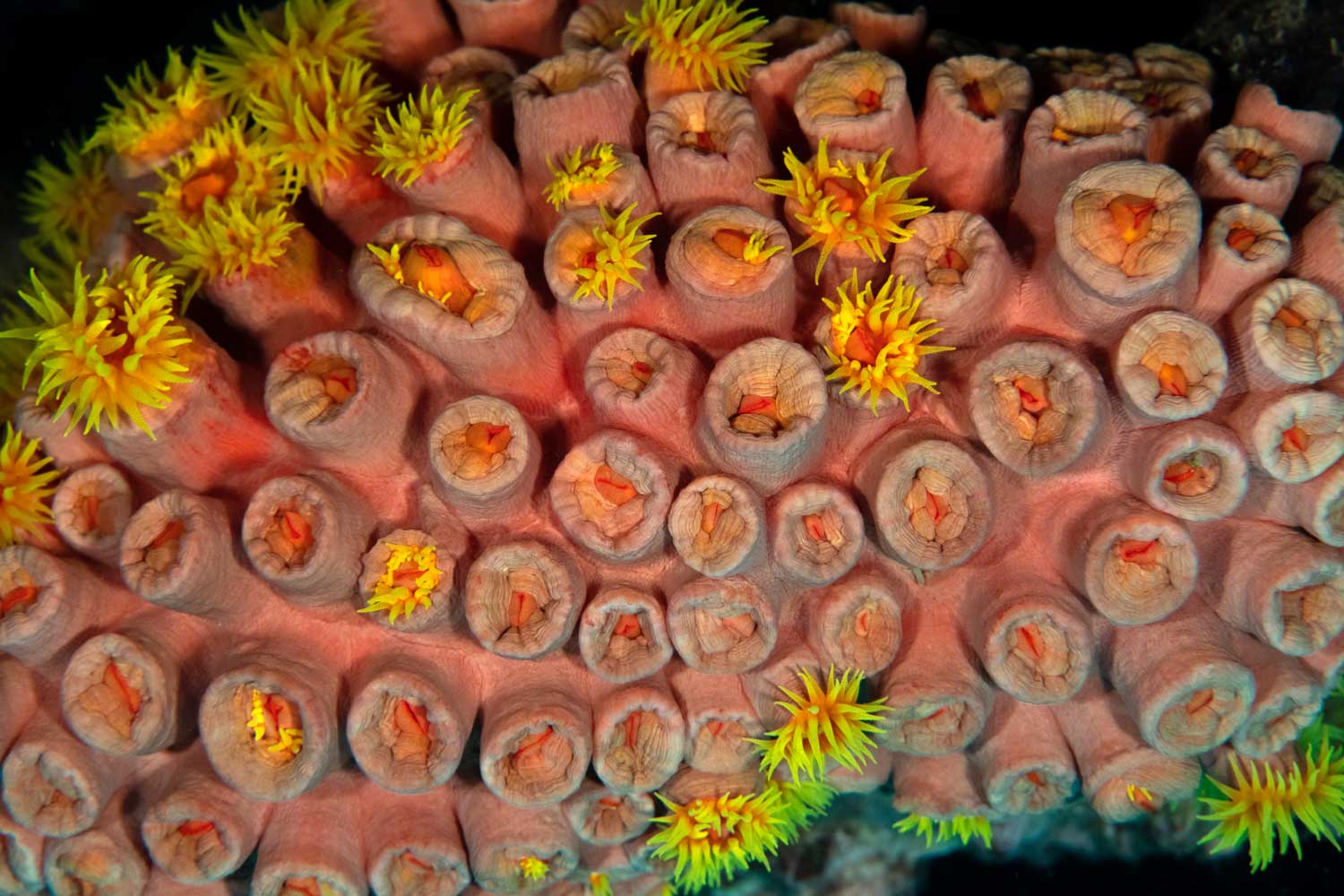
Coral close-up
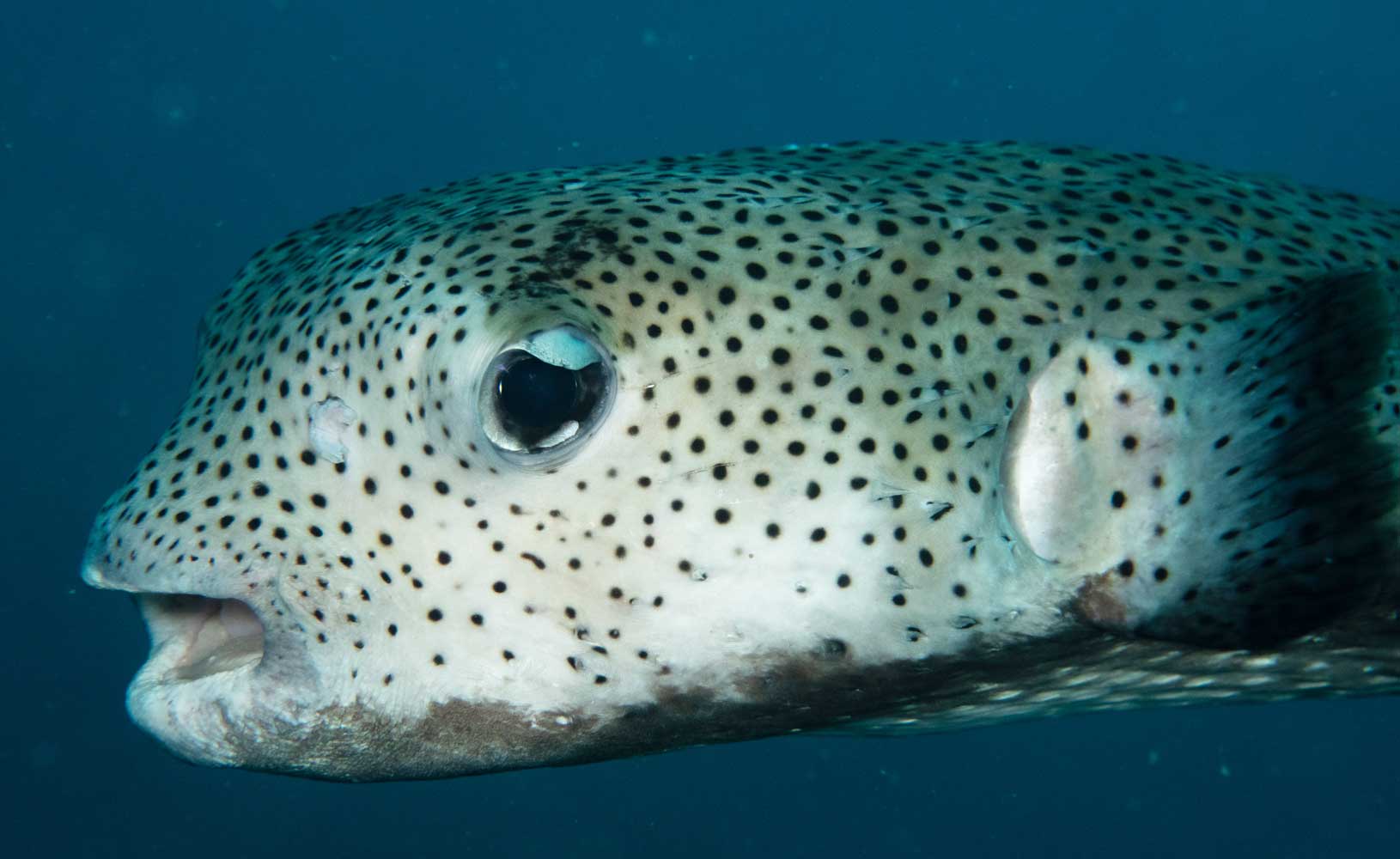
Black-spotted
porcupine fish (Diodon Hystrix) can inflate itself by swallowing water
to
deter the potential predator with its larger volume and raised spines. It
also contains
tetrodotoxin in certain parts of its body such as the liver,
skin, gonads, and the viscera.
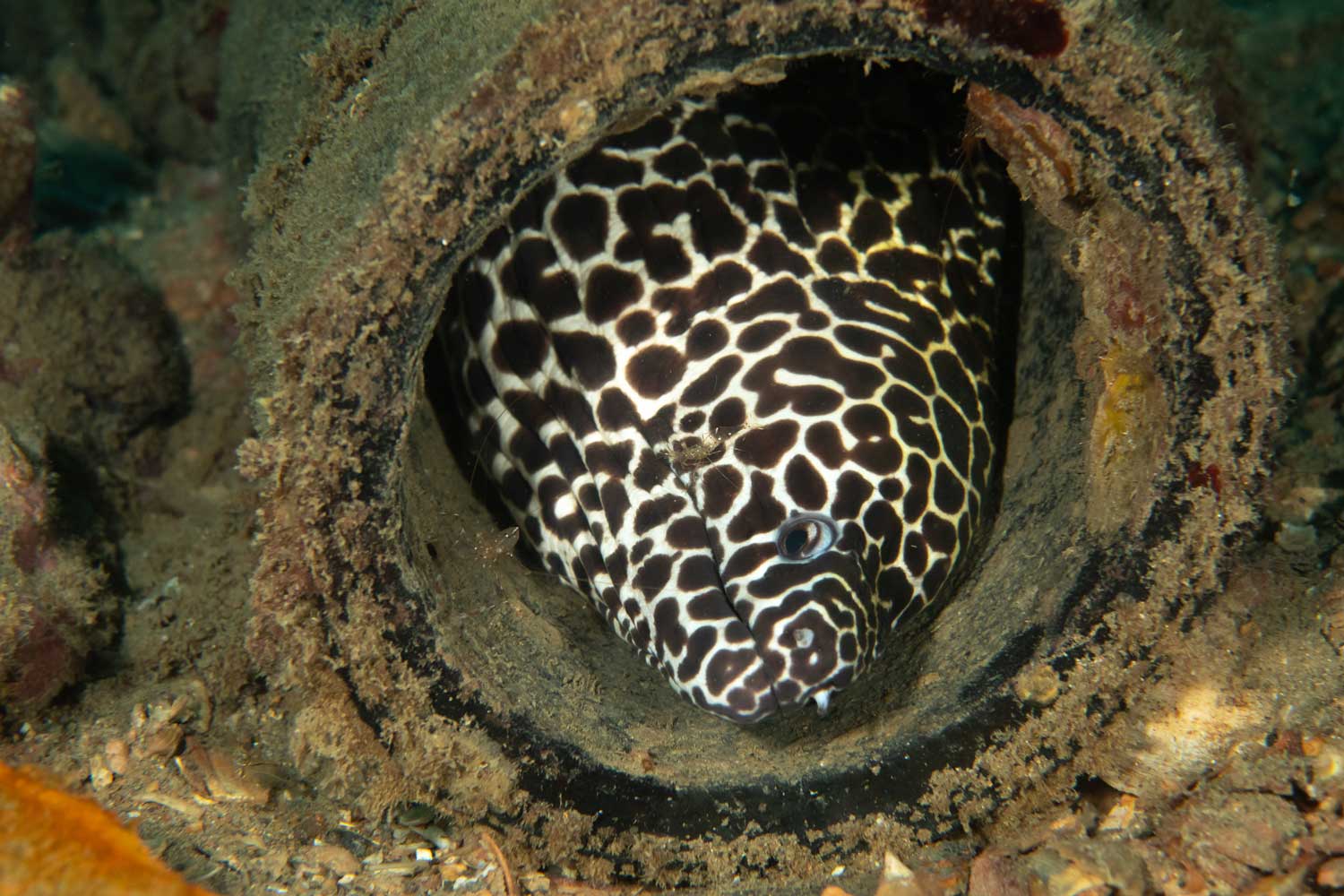
Lots of
honeycomb moray eels (Gymnothorax favagineus) hide out here.
You can just
see the cleaner shrimp at the corner of the eel’s mouth.
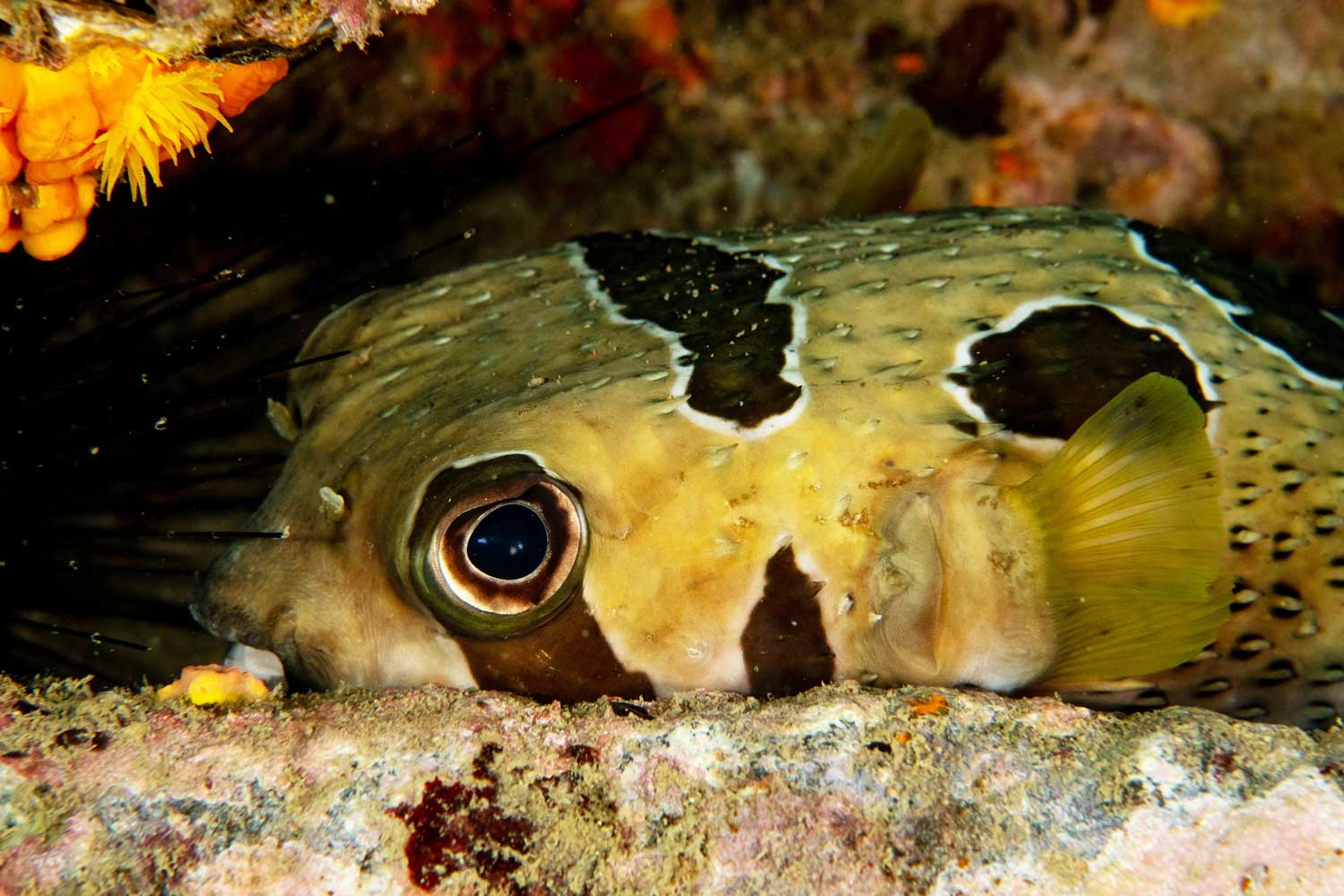
A blotched
porcupinefish (Diodon liturosus) takes a snooze. This fish is solitary except
during mating
periods and is most active at sunset and sunrise. During the
day it normally hides in caves or under ledges.
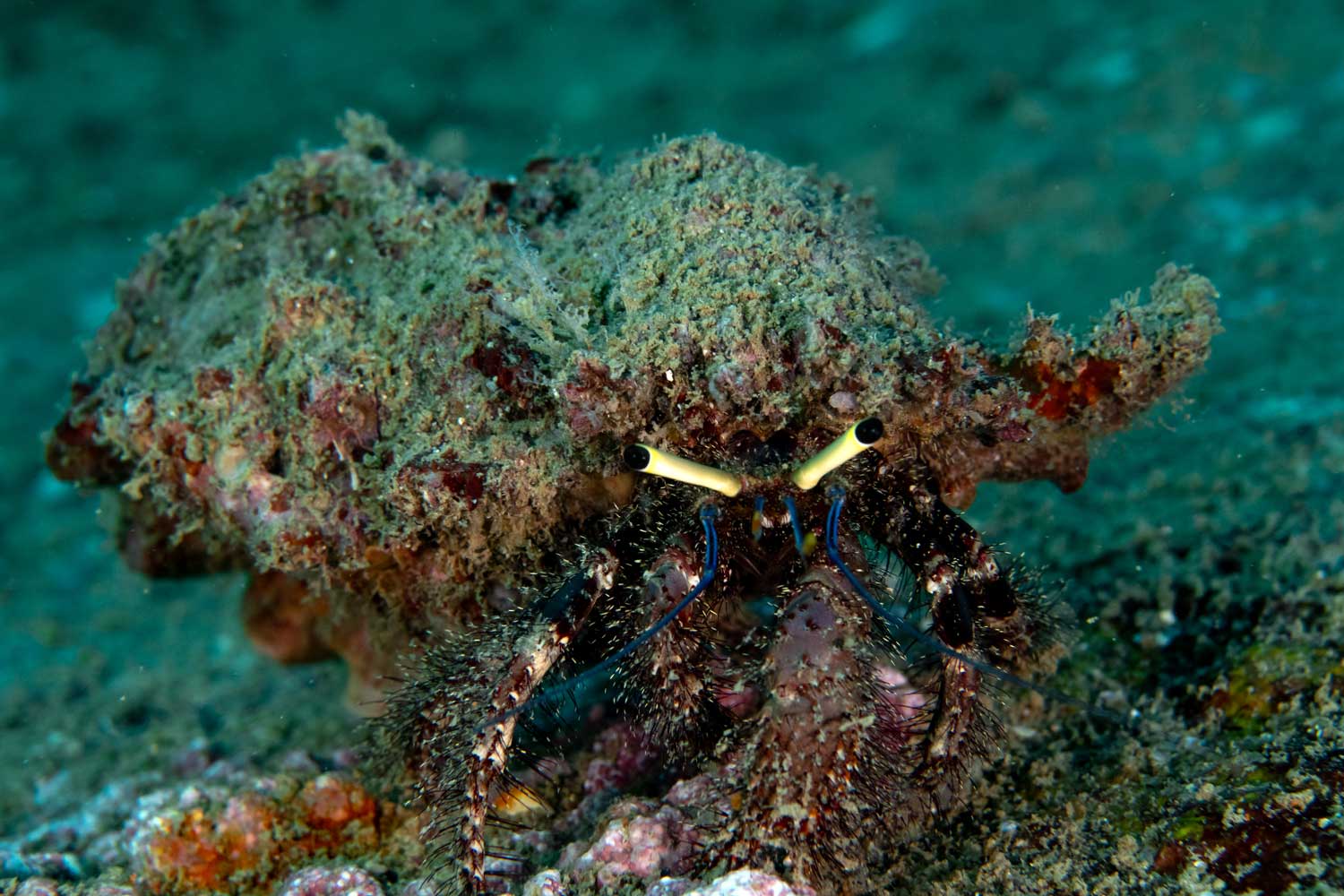
A very well
camouflaged crab!
Luca told us that the Premchai Wreck had
been a log carrier caught by an unusually low tide and damaged beyond repair, so
was sunk as an artificial reef. Internet sources, however, described it as a tin
mining dredge. It had sunk more recently and remained mostly intact, though
lying at a topsy-turvy angle. Fish, including many juveniles, filled the dark
chambers and we saw many of the same species as at the Boonsung Wreck.
We then motored slowly back to port while enjoying an Italian lunch. But
something went terribly wrong afterward as I was sitting at the back of the
boat. First my stomach became upset and heaved lunch overboard, then I became
extremely dizzy as well as nauseous. Luca came to the rescue and helped me to a
seat to lie down—I wasn’t able to walk on my own—and I rested awhile hoping the
dizziness and nausea would subside. They didn’t. Apparently I had gotten the
‘bends’ from excess nitrogen despite using Nitrox and keeping within the time
and depth limits of my diving computer. When things didn’t improve, Luca
arranged for an ambulance to take me to the local hospital, where staff made
some tests before deciding I should go to a major international hospital and a
recompression chamber at Phuket. A long, bumpy ambulance ride eventually brought
me to the gleaming white interior of Siriroj International Hospital, where I
went to the I.C.U. All during this time medical staff had me on pure oxygen to
reduce the nitrogen in my system. Nurses hooked me up to a saline drip as well
as an E.K.G. monitor and frequently checked my blood pressure. That night I went
into the recompression chamber for a five-hour treatment to a ‘depth’ of 18
meters (60 feet), also breathing oxygen for long periods, then gradually brought
back up to normal atmospheric pressure. The cylinder-like chamber had double
pressure doors, a medicine airlock, and two cots. One specialist stayed inside
with me while an operator ran the controls outside. To pass the time, the fellow
with me had a projector positioned outside a porthole at one end to show a pair
of movies onto a screen inside, but I was still too nauseous to watch anything.
For some divers who have decompression sickness, the chamber treatment provides
a miraculous improvement. For me it made no noticeable improvement in my
condition, but it I knew it had greatly reduced my nitrogen levels.
9-11
December Phuket
I ended up staying four days in the I.C.U., and following the
doctor’s advice to take three more chamber treatments, one of five hours, then
two of three hours. Chamber treatments cost a fortune, about $2,600/hour, and I
couldn’t tell if all that time inside was worth it. Walking was still perilous
and I needed help anytime I left my bed. A couple days passed before I could eat
again. My problems seemed entirely related to nitrogen causing the inner ear
balance to go awry. People also noticed a rash that wrapped around my
midsection, a symptom of excessive nitrogen. And I noticed tiny dark spots had
appeared on my hands and arms that resembled those of a very old person.
Fortunately the rash and spots faded away in a few days. My last meal on the
boat had been spaghetti, and that was the first meal offered at the hospital,
which made me sick to my stomach from just the smell. Later I found I could eat
soups, then soon graduated to solid foods. I also got lots of little pills to be
taken before and after eating for reducing nausea and dizziness. Each day I go a
little better with decreasing dizziness and complete ending of the nausea. On my
last morning at the I.C.U. a fellow came by to provide my choice of a walker or
a four-legged cane. The walker seemed to make more sense as I was still very
wobbly, but I went with the cane, which proved the better choice.
I had
neither hospital nor dive insurance, but Similan Diving Safaris did! That would
cover up to 500,000 Thai baht, I was told, about US $15,000 or about two-thirds
of the total bill. When I became ill I had lost track of all my gear and
clothing, but people had brought it to my room in the I.C.U. except for
valuables that went into a deposit box. I retrieved my phone and computer, but
it was too late to cancel my Bangkok Airbnb reservation, so that was $96 lost.
And I wouldn’t be flying to India as planned this week, so that was another $137
lost. I did manage to cancel my first Airbnb reservation for India with just a
small service fee.
12-20 December Phuket
I could barely walk, but the
main doctor thought I could leave the hospital. I hoped to find a hotel room
nearby and through Google maps located the good-value S.B. Park Hotel less than
a kilometer away, which I reserved through Agoda. The hospital arranged for a
taxi to take me to the hotel, where I stayed nine nights, getting a little
better each day. Friendly women staff arranged meals and laundry service.
An ear doctor had given me a treatment while I was at the hospital, and I was to
come back for an appointment with another ear doctor two days after leaving the
hospital. On my return the ear doctor said that a loose ‘crystal’ of my inner
ear had settled back into place properly. I also saw a neurologist, who gave me
simple tests and asked that I come back for an appointment in a week, though
that was later moved up a few days, when he gave me a clean bill of health. I
had taken a taxi to back to the hospital for the first pair of appointments, but
managed to walk back to the hotel OK. I then went for walks every day, returning
on foot for the second appointment and making many visits to nearby Bollywood
Phuket Restaurant for tasty Indian cuisine.
Phuket is Thailand’s largest
island, but is really just a hilly peninsula that has been cut off by a narrow
channel, and is so large that it doesn’t feel like an island. As it turned out I
never even saw the sea during my visit! Phuket has a reputation for
hard-partying beach resorts, and a lot of package tourists come here. That’s not
my scene, nor would cycling in the heavy traffic be any fun. I could have
visited historic buildings and temples of Phuket town and viewpoints in the
hills, but the only way to get around is by taxi and drivers demand exorbitant
rates, even the internet Grab taxis. So I mostly hung out around my hotel and
worked on photo and writing projects during the recovery time.
Surprisingly I knew someone in Phuket, a Facebook friend from the U.S.A. who is
teaching here along with his wife. They picked me up on Saturday and we went to
one of their favorite restaurants for a chat over coffee and tea.
By the
end of my stay at the hotel, I found that I could walk fine without the cane. My
balance hadn’t recovered completely, and when I turned my head rapidly, it felt
uncomfortable. My Thai 30-day permit would expire the night before Christmas,
and I felt confident enough to resume travels. I bought an online VIP bus ticket
to Bangkok, a 13-hour trip, for Friday night, then got another Air Asia ticket
to Bengaluru in India for Saturday night, the only day with bargain-priced
tickets—actually cheaper this time at $113.61.
21 Dec. Bus ride
Phuket-Bangkok
Most people would fly from Phuket to Bangkok as the cost is
low, but the cheaper flights tend to go in the middle of the night. I figured
the bus would be OK as it departs and arrives at convenient times and the bus
stations have more convenient locations. I had all morning at the hotel for
internet work and packing, then an Indian lunch. The hotel arranged a 300-baht
taxi ride to the bus station, which seemed expensive, but heavy traffic made for
a slow trip. There’s little to like about Phuket, and I hope never to return!
Check-in for the bus ride was a snap, and the bus headed out shortly after dark.
The VIP bus meant only three seats across, so I had a very roomy seat.
The journey continues with South India Backpacking Dec. 2018-Jan. 2019
Back to Beginning of Southeast Asia Backpacking Nov.-Dec. 2018